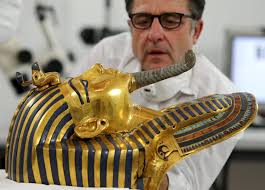After two months of intensive restoration work, by a German- Egyptian team, Tutankhamun’s gold mask was back on display at the Egyptian museum in December 2015.
The beard of pharaoh actually fell off in August 2014 after, removing the mask from its display case in order to change the lighting system; after the beard fell the workers of the museum tried to fix the beard by applying normal glue over the mask. The amount of the glue was actually a lot and it left a visible crust on the priceless mask.
After discovering the incident the antiques ministry held a press conference and a German-Egyptian team of experts, lead by Christian Eckman was assigned to accomplish the restoration mission. It took more than two months to restore the mask.
The process included a 3D scan of the mask and a carful warming procedure to remove the glue.
“The most difficult and challenging process was removing the beard; the mission was accomplished by applying technical means and using wooden tools,” Christian Eckman stated.
A detailed study of the mask’s manufacture technique was also conducted by the restoration team in order to gain more information about the materials and techniques implemented by ancient pharos in manufacturing their antiquities.
It is to be noted that the 3,300 year old mask is one of the precious pieces found along with hundreds of items in Tutankhamum tomb, which was discovered in 1922.
The mask is considered one of the main attractions at the Egyptian museum; it weights 11kg and it is covered by lapis and precious stones.
The tomb was discovered by the British archaeologist Howard Carter in Luxor’s Valley of the Kings. Carter actually accomplished the first restoration mission for the mask 90 years ago as the beard was already loose.


